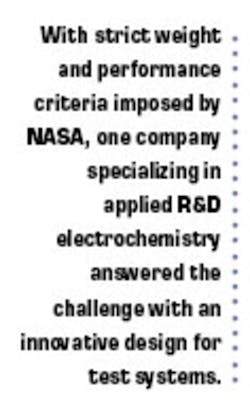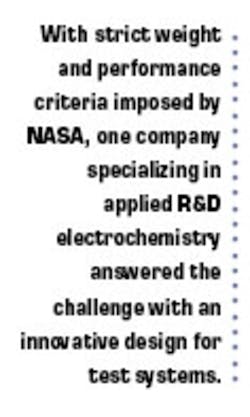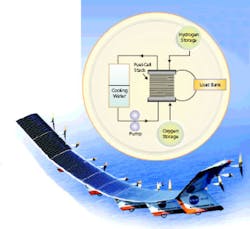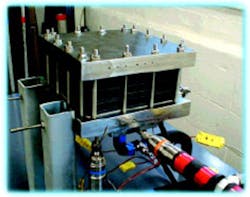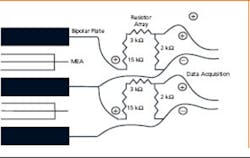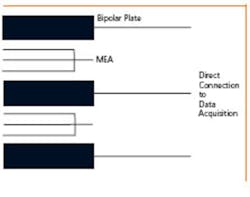When you’re flying 20 miles high, it’s not the time to run out of gas. Such was the major challenge facing engineers developing an innovative fuelcell- based power system during the design of Helios, the latest unmanned aerial vehicle (UAV) built by NASA and its partner AeroVironment.
Regenerative Energy System
Earlier Helios designs used solar panels as their energy source for daytime flying, with excess solar energy charging batteries for overnight flight. The battery system proved heavy and was not a viable solution.
A lightweight alternative comprising solar panels, a fuel cell, and an electrolyzer was the answer. In flight, the solar panels’ excess daytime power operates the electrolyzer to produce hydrogen and oxygen. At night, the fuel cell converts those gases back into water and electricity, keeping Helios aloft.
After successful initial design and testing, AeroVironment selected Giner Electrochemical Systems to develop a regenerative power system for the Helios project. In business since 1973, we conduct applied R&D in electrochemistry and related areas.
We first designed a 50-cell proton exchange membrane (PEM)-based electrolyzer that converts liquid water into gaseous hydrogen and oxygen by electrochemically splitting water into hydrogen and oxygen gas (Figure 1a). Next, we designed a 60-cell PEM-based fuel-cell stack that combines gaseous hydrogen and oxygen into liquid water, producing electricity.
The electrolyzer stack produces nearly 4,000 l/h of gaseous hydrogen, operating at a current density of 1,000 A/ft2, with individual cell voltages of 1.73 VDC. For earthbound testing, the driving force in this reaction is a power supply. The 5-kW fuelcell stack operates at 500 A/ft2, providing 850 mV per electrochemical cell (Figure 1b). A load bank draws power from the fuel-cell stack for testing.The innovative concepts used in the fuelcell and electrolyzer stacks result in stacks weighing approximately 20 lb each. These stacks operate at 400 psig, high pressure compared to typical fuel-cell operation at 30 psig.
Testing Environment
The test goals were two-fold: evaluate the performance and endurance of the regenerative power system to meet weight and performance goals and speed the process of data acquisition, measurement, control, and data reduction. The test system was designed to reliably monitor and control high-pressure testing of explosive gases over a range of currents, voltages, pressures, gas flows, water flows, and temperatures. This system includes a variety of autonomous safety measures and provides long-term operation with minimal user intervention.
The test system had to be reliable and provide the precision data acquisition and control required to demonstrate the capabilities of the stacks.
During testing, the total voltage was 51 VDC (0.85 VDC/cell) on the fuel-cell stack and 86.5 VDC (1.73 VDC/cell) on the electrolyzer stack. These measurements needed a precision of ±0.5 mV. The pressure and flow values were measured in the 0 to 5 VDC range, based on the individual sensor outputs. Other measurements included lowvoltage (K-type) thermocouple and shunt readings, both in the millivolt range.
The test stands operated at pressures ranging from 0 to 400 psig, temperatures ranging from 60 to 180°F, gas flow rates up to 4,000 l/h, voltages up to 100 VDC, and currents up to 175 A (Figure 2).
Testing Challenges
The land-based test stands presented a variety of difficult problems. For example, the cells in the stacks, which act similar to batteries in series, create low point references on cells up to 98 VDC. In previous test systems, voltage divider arrays connected to a data acquisition system and a PC were the means to measure voltage, pressure, temperature, flow rate, and current, as shown in Figure 3a.
The use of divider arrays introduced errors, which were unacceptable for the precision measurements required of the test system. The inherent error in each resistor could be corrected in the data acquisition software but required standardization of each resistor array. This, in turn, caused each array to have a different scaling factor, increasing the complexity of the data acquisition programming manyfold. A more reliable solution was needed to continue testing of the electrochemical stacks and process variables.
The DT9800 Series Data Acquisition Modules from Data Translation, selected for the new test system, enabled direct readings of the stack properties. We could accurately detect which membrane electrode assemblies (MEAs) were operating within or outside of the specified operating parameters of DC voltage and AC resistance at specific current densities.
We also selected Data Translation’s USB Module because it consolidated analog in-put/output and a digital input/output on a single board. The DT9800 Modules have an amp low connection that allows the single-ended inputs to be used in a pseudo-differential mode. All 16 single-ended inputs on each module operate relative to the amp low common voltage.
Connections to the bipolar plates on the stack are made using pogo pins, spring-loaded contact pins held in place on each bipolar collector. These pins are soldered to 25-conductor, twisted-pair ribbon cables with shields. The ribbon cables connect via 25-pin IDC D-subminiature connectors to a cabinet containing the data acquisition modules.
Completion of preoperational checks, including connection of the stack, takes about 10 minutes. This is very rapid compared to the prior test system, where all the checks were performed manually and took 45 minutes. Following preoperational checks, the system can be operated over the entire range of pressures, temperatures, and current densities or placed into a constant mode of operation at specific temperatures, pressures, and current densities.
The present test system requires significantly less user intervention and supports testing of larger electrochemical stacks. The previous system only tested fuel-cell stacks that were 500 W or less and electrolyzer stacks that were 1.5 kW or less. The upgraded system tests up to 10 and 30 kW of power, respectively.
Data Translation’s solution provided us with the flexibility to set the low reference point essentially wherever necessary to measure ranges of cells. Each module’s reference point is set midrange to the cells that are connected to it. For example, if fuel cell MEAs 10 to 20 are connected to one module, the reference point is set to a potential equal to the middle of the range of those cells or approximately 15 V. Separate isolation of each module allows the module grounds and the stack ground to be the same while floating the low reference point to the appropriate voltage for the cells connected to a specific module.The data acquisition system was designed for highspeed processing of signals up to 2 kHz as well as reliable signal acquisition and control. The highfrequency measurements are required to eliminate aliasing of square-wave signals used to measure the AC resistance of each cell in the stack. This measurement allows for diagnosis of the water content in each membrane, which is extremely useful in informing the operator of the condition of each MEA.
The data acquisition modules control these testing parameters, placing the entire system under computer control. The final version of the test stand will operate unattended for up to 72 h.
Conclusions
We met the strict weight and performance criteria imposed by NASA. The use of Data Translation’s USB DT9800 Series Data Acquisition Modules increased the flexibility and decreased the complexity of the test system used for earthbound testing, with fewer connections and less equipment reducing the opportunity to introduce errors.
About the Author
Matthew Steinbroner is a project manager at Giner Electrochemical Systems, focusing on high-pressure fuel cells and electrolyzers. He began his professional career at The Electrosynthesis Company and, in 1999, moved to the Boston area to work for Giner. Mr. Steinbroner received a bachelor’s degree in chemistry from the State University of New York at Fredonia in 1997. Giner Electrochemical Systems, LLC, 89 Rumford Ave., Newton, MA 02466, 781-529-0536, e-mail: [email protected]
March 2002
